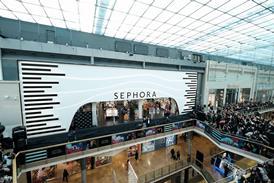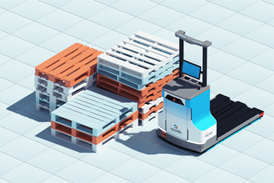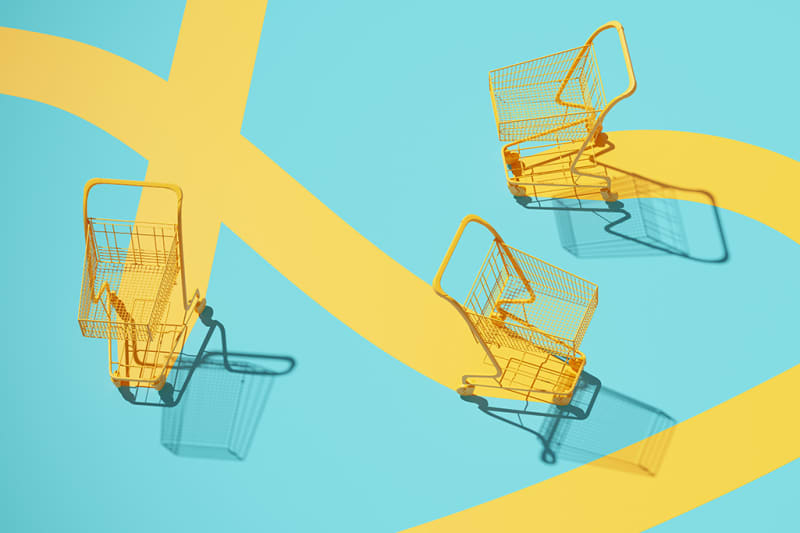How nine
retailers are
supercharging
their
marketing
with AI

Retail has crossed the AI precipice. The industry has moved from eyeing up the forward-thinking strategies of the largest global players to more widespread investment in various AI applications now gathering steam.
Retail Week research interviews conducted in May and June 2024 saw 39 UK CEOs asked to rate their AI capabilities from one, meaning no use of AI, up to 10, meaning highly proficient and used across multiple business areas. Just five (13%) rated themselves at one; the vast majority (62%) scored themselves between two to five; but a significant 24% rated themselves between six to eight, reflecting the sudden strategic speeding up in this area.
The same research showed which business areas have seen the greatest AI investment. Ecommerce CX led the way with 64%, followed by marketing at 49% and improving use of data at 46%.
Significantly, retailers recognise the power of AI to inform decision-making, automate routine tasks and personalise messaging to customers.
But, which retailers are turning AI theory into practical reality?
This question is tackled in this deep-dive article – the fifth in our six-part series Consumer 2025 – from acquisition to advocacy produced in partnership with Bloomreach. Powered by AI, Bloomreach personalises the ecommerce experience, unifying real-time customer and product data across channels so businesses understand what customers really want. The series is designed to analyse how the retail sector will rise to meet the evolving and growing expectations of consumers.
Here we look at nine retailers that are integrating AI into their marketing and reaping the benefits.
Andrex
- Sales of £442.5m (+10.5%), according to data from NiQ
- Andrex has added £41.9m on units that have dipped just 0.5% – with its more premium lines gaining share
- By combining retail data from Ocado with AI, Andrex was able to deliver a return on ad spend that exceeded expectation by more than five times
Andrex has a large and loyal customer base, but it wanted to expand its audience and grow its business.
Ocado worked with PHD Media and shared pseudonymised consented transaction data with programmatic specialists The Trade Desk; these included product purchases, the time of day a purchase was made and the amount spent by a customer.
This data was fed directly into The Trade Desk’s media buying platform, which used AI to sort and analyse approximately 15 million ad opportunities per second. The resulting insight on consumers’ engagement with the creative included which format or website drove the most sales, what time of day engagement spiked and which audience segment engaged with it the most.
Insights were accessible while a campaign was live, meaning it could be optimised in real time or the creative or channel changed to maximise impact.
The combination of Ocado’s retail data with AI meant the return on ad spend exceeded expectation by more than five times. The campaign also helped Andrex better understand its customers’ purchase journeys. For example, online customers buying Supreme Quilts took on average two fewer days to purchase than customers buying other Andrex products, while the target audience preferred to convert using mobile devices (54% of sales) versus tablets (2%).

PrettyLittleThing wanted to turn lapsed customers into loyal brand advocates with its re-engagement campaign
PrettyLittleThing wanted to turn lapsed customers into loyal brand advocates with its re-engagement campaign
PrettyLittleThing
- The retailer’s owner Boohoo Group reported a revenue of £619.8m in H1 FY25, down 15% year on year, with gross profit falling 19.2% to £314.4m
- Founded in 2012 by Umar Kamani, he returned to lead PrettyLittleThing in September 2024 after departing in 2023
- The fashion retailer has partnered with Bloomreach to better personalise marketing, increasing revenue per email by 30%
The online womenswear retailer wanted to use its customer data to personalise its marketing campaigns down to an individual level, to reduce the risk of customer churn.
Historically, PrettyLittleThing targeted lapsing customers with a templated re-engagement campaign that used the same messaging for every single inactive customer, sending those messages at the same time interval since their last purchase. For those customers who had purchased something and then not returned to re-engage with the brand after an allotted period, this would then trigger an incentive-based campaign to encourage them to start spending again.
However, PrettyLittleThing wanted to go a step further with a more personalised approach to turn these customers into loyal brand advocates. This is where the fashion retailer’s partnership with Bloomreach came in.
PrettyLittleThing worked closely with Bloomreach’s consulting team to build a re-engagement journey for lapsing customers that took their individual behaviours into account to serve the right message at the right time.
Using email, mobile push notifications and SMS, the brand created a workflow that took into account the customer’s last purchase and all of their interactions with PrettyLittleThing. This included time between purchases, engagement with previous campaigns, channel preferences and more. This enabled it to create hyper-relevant customer segments, tailoring messaging and send-times to an individual level.
“Our re-engagement journey used to speak broadly to customers, without taking their unique needs into account. Now we can personalise them, reaching every single person on the right channel with the right message. It’s completely revamped our reengagement journey, and we’re excited to continue testing and improving this campaign,” says Victoria Pinion, assistant customer relations manager at PrettyLittleThing.
With personalised re-engagement workflows powered by Loomi, Bloomreach’s AI for ecommerce, after just two weeks of implementing these changes, the brand saw 30% more revenue per email sent and 133% more revenue per mobile push notification.
Versace
- Turnover for the fiscal year to March 30, 2024, was $1.03bn (£795m), down from $1.1bn (£849m) in the year to April 1, 2023. The brand saw declines in EMEA of 5% to $444m (£343m) and in the Americas of 17% to £338m (£261m), but a rise of 8% to $248m (£191m) in Asia
- Versace’s first quarter 2025 results revealed its global database increased by 1.3 million new consumers, representing 20% growth over the past year
- Versace’s ‘New Digital Artists’ campaign tasked 25 digital creators to produce AI-generated content inspired by its brand new Greca Goddess Top Handle Handbag
Versace’s ‘New Digital Artists’ campaign aimed to explore new technologies and their influence on the creator community. The goal was to lean into creators who are using generative AI as a muse, to showcase the Versace product in a way it had never been seen before.
The brand tasked 25 digital creators to create AI-generated content inspired by its brand new Greca Goddess Top Handle Handbag. The creators interpreted the handbag through their own lens and introduced the brand to their audience in a new way. The bag was at the forefront of the content but was brought to life by the creators’ imagination.
The average engagement rate for the various content creations was 5.7%, while one Versace asset alone generated 3.9 million organic views, far outperforming standard industry benchmarks.
Versace’s ‘New Digital Artists’ campaign tasked 25 creators to produce AI-generated content to showcase its new Greca Goddess Top Handle Handbag
Versace’s ‘New Digital Artists’ campaign tasked 25 creators to produce AI-generated content to showcase its new Greca Goddess Top Handle Handbag
Versace’s ‘New Digital Artists’ campaign tasked 25 creators to produce AI-generated content to showcase its new Greca Goddess Top Handle Handbag
Versace’s ‘New Digital Artists’ campaign tasked 25 creators to produce AI-generated content to showcase its new Greca Goddess Top Handle Handbag
Reckitt Benckiser used a GenAI-based digital asset management (DAM) system aimed at reducing waste, reusing assets and managing rights
Reckitt Benckiser used a GenAI-based digital asset management (DAM) system aimed at reducing waste, reusing assets and managing rights
Reckitt Benckiser
- Reckitt’s 2023 Annual Report showed a 3.5% like-for-like net revenue growth, while half-year 2024 figures showed net revenue growth of 0.8%, with net revenue of £7.2bn
- Reckitt piloted a GenAI-based digital asset management system, with results including up to 60% faster concept development
This year hygiene, health and nutrition company Reckitt Benckiser unveiled the results of a series of pilots across its Gaviscon and Finish brands, using a GenAI-based digital asset management (DAM) system aimed at reducing waste, reusing assets and managing rights. The system is designed to assess whether required assets are already available or can be produced or adapted by GenAI.
According to Reckitt chief marketing, sustainability and corporate affairs officer Fabrice Beaulieu: “The results of our recent GenAI pilots demonstrate the technology’s huge potential to maximise the impact of brand activations, drive consumer engagement and foster more sustainable practices. We are acting upon the insights from these pilots, including by creating our own technology to surface fresh insights from consumer information and leveraging GenAI to develop marketing concepts.”
Results included up to 60% faster concept development – for example, through Finish’s use of retrieval-augmented generation (RAG) to turn 10,000s of pages of consumer data into new ideas and marketable concepts.
DBS Bathrooms
- DBS Bathrooms reports that it has seen sales increase by £45,000 over the past year (online and offline), with a 2.5% boost in overall website income
- Sales via Amazon have seen a 40% increase year on year
- The retailer has used AI to optimise efficiency, including writing product copy and boosting search engine optimisation (SEO)
DBS Bathrooms utilises SEO, paid search and paid social channels to grow brand awareness, drive commercially relevant traffic to its site and deliver more direct sales.
The retailer is competitive on price in a close-knit space and needed to find efficiencies in its processes to give its team the bandwidth to explore new opportunities to diversify.
DBS Bathrooms co-director Cory Powell says AI enabled the company to improve its marketing approach in ways that “would have been challenging, time-consuming and cost-prohibitive through traditional methods”. Using AI-powered tools and strategies allowed DBS to create a more personalised, efficient and data-driven marketing ecosystem.
Key to its approach to using AI was to measure and improve the human-to-AI ratio. “For example, a team of five could utilise AI so efficiently that their productivity is like having an additional person,” says Powell. “This 5:1 ratio illustrates how we blend human expertise with AI capabilities to optimise productivity and creativity.”
DBS uses AI to write product copy for its website, informing the customer and boosting SEO performance. “However, this needs to be carefully balanced with techniques and tools that blend the organisation’s tone of voice and brand guidelines with the speed offered by AI. This was a key element of our work together on how to utilise AI as a thought partner and increase the human-to-AI ratio in the business,” Powell says.
Following the use of AI in numerous small tasks across its SEO strategy, including writing product copy, DBS was able to increase organic revenue by 35% year on year in August to £229,000.
DBS Bathrooms utilises SEO, paid search and paid social channels to grow brand awareness
DBS Bathrooms utilises SEO, paid search and paid social channels to grow brand awareness
Xiaomi
- Xiaomi was one of the fastest-growing smartphone brands in H1 2024, racking up 22% year-on-year growth in sales volumes
- The electronics retailer is now number two in global smartphone sell-through volumes
- Xiaomi worked with an AI artist to produce images that reimagined its stores for its Instagram winter competition, achieving brand channel reach of 11 million
Chinese electronics brand Xiaomi moved up to number two in global smartphone sell-through volumes in August 2024. It sells its own brands and sub-brands, but only sells direct online in the UK, or in store via retailers such as Currys. The company wanted a new way to encourage audiences to participate and promote its Instagram winter competition, #WrapXiaomiUp. Xiaomi social content has a strong focus on people photography and the brand needed to showcase more creative content to stand out from the crowd.
Influencer marketing agency Billion Dollar Boy collaborated with AI artist @Joooo.ann to produce AI-generated images that reimagined how the Xiaomi stores might look in the North Pole using ‘festive season décor’ as a guiding theme. This resulted in a number of vivid and unusual images. Reach on Xiaomi’s Instagram brand channel was 11 million.
Rodalink
- Rodalink started in 1997 as the first bicycle retailer in Indonesia and now belongs to the group of Insera Sena, one of the biggest bicycle manufacturers in Asia
- Rodalink has established an extensive international operating platform and distribution network, and now has more than 50 stores in Asia
- Rodalink leveraged AI to optimise content, resulting in a 252% increase in conversion rates for orders
Indonesia-based bicycle retailer Rodalink partnered with UK online marketing company Dotdigital in 2023, with a view to upgrade its marketing automation capabilities. The key challenge was to maintain quality campaign creation.
Without a dedicated platform support team, the brand found it difficult to navigate and capitalise on its potential, and struggled with creating engaging subject lines and creative copy for campaigns across diverse markets. Rodalink wanted to ensure its content was highly relevant and interesting to the target audience.
Using Dotdigital’s AI engine WinstonAI™️, Rodalink was able to overcome creative hurdles by accessing useful suggestions and options that could improve open rates and click-through rates.
The team utilised the technology for both subject lines and content within Dotdigital’s email builder, receiving suggestions on how to enhance overall campaign content.
While WinstonAI’s recommendations were offered in English, they were simple enough to be translated into Indonesian thereby optimising the content for the audience of Rodalink Indonesia.
WinstonAI also suggested translating customer reviews and incorporating them as selling points in campaigns. In the spirit of A/B testing, the brand experimented with different call-to-action (CTA) phrases in its emails, such as “Check Service Fee” and “Our Location”, based on recommendations from WinstonAI to improve CTAs.
Rodalink Bike Store saw a 10% increase in web sessions from email and a 252% increase in conversion rates for orders. There was an increase of 54% in open rates using the subject line suggestions by WinstonAI; and through the CTA copy test the brand found that its target audience was more compelled to click on “Check Service Fee” leading to an industry-surpassing 60% click-through rate.
Rodalink worked with Dotdigital to use an AI engine to improve email marketing campaigns and click-through rates
Rodalink worked with Dotdigital to use an AI engine to improve email marketing campaigns and click-through rates
THG uses adaptive AI to predict influencer revenue
THG uses adaptive AI to predict influencer revenue
THG
- THG's turnover for the first quarter of 2024 was £455.4m, a 4.5% increase in revenue compared with the previous year
- THG has achieved growth progression in each of the past five consecutive quarters and the business focused on higher-margin sales through FY 2023
- THG uses AI to enrich customer profiles, accelerate business processes and predict influencer revenue
Health and beauty retailer THG uses adaptive AI to gather and process data about its customers to create richer profiles. For example, this can include information on journeys, add-to-basket activity and purchases, as well as predicting a customer’s ‘lifetime value’ based on their behaviour.
THG also uses AI to streamline its business processes, such as using machine translation to translate copy about products into other languages using the brand’s house style, as well as fraud detection, anomaly detection and profanity detection in comments, which work in more than 78 languages.
Adaptive AI is also deployed in THG’s influencer revenue forecasting, helping it to select the optimum influencer to work with. By using AI to predict the revenue an influencer can be expected to generate, campaign managers are able to make informed decisions more quickly, leading to better return on investment.
Marks & Spencer
- In the 2024 financial year, Marks and Spencer (M&S) achieved its highest ever revenue, with a total of more than £13bn globally; an increase of over £1bn from the previous year, which was also a record year
- Online sales increased 7.8%, with growth accelerating in the second half as online marketing had more impact, particularly in womenswear
- M&S has deployed AI to create product descriptions, tailor the tone of communications and recommend clothing products
Marks & Spencer has revamped its online presence, which includes the use of GenAI to write 80% of its product descriptions – improving browsing time by half a second – aimed at listing and selling products more quickly.
AI will also adapt the language used to address shoppers, tailoring the approach to six different preferences including emotional, descriptive language or more straightforward prose. One of its aims is to personalise online interactions with shoppers, such as prioritising the most relevant products for an individual.
Shoppers can also opt to fill out a quiz about their size, body shape and style preferences within the retailer’s app in return for receiving relevant outfit ideas chosen by AI from 40 million options, which is anticipated to drive additional sales. M&S director of online Stephen Langford said in September 2024 that 450,000 M&S shoppers have used the quiz so far.
The service combines ideas from the retailer’s in-house stylists with information from the shopper, offering tips on which garments complement each other. The automation of product descriptions using AI has risen to 80% from almost nothing in the past year, although Langford said humans are still needed to sense-check the process.
Marks & Spencer uses GenAI to write 80% of its product descriptions
Marks & Spencer uses GenAI to write 80% of its product descriptions
Consumer 2025 – from acquisition to advocacy



































